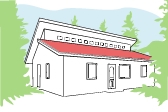
Clerestory roofs allow in plenty of natural light while still preserving privacy, and allow for effective passive heating and cooling when they’re correctly designed.

What is a clerestory roof?
A clerestory roof is a roof with a vertical wall which sits between the two sloping sides, which features a row of windows (or one long, continuous window). The clerestory roof can be symmetrical, with a hipped or gable-type design, or else it can be asymmetrical, resembling something closer to a skillion roof. The main feature of a clerestory roof is that it incorporates a row of clerestory windows in the vertical panel between the two sloping roof planes. The row of windows forms a ‘clear storey’.
Why install a clerestory roof?
Ancient Egyptian and Classical Greek and Roman architects installed clerestory roofs in large buildings designed for public use, including churches, temples, bathhouses and palaces. The row of windows helped to admit light and to circulate air, and was set high above eye level in order to prevent people from peeping in and gazing out.
In more modern times, clerestory roofs were commonly incorporated into factory or warehouse plans to improve natural lighting. Recent interest in more environmentally friendly buildings, which favour passive heating and cooling techniques over artificial methods, has seen clerestory roof design reemerge. The added privacy afforded by the high windows is particularly appropriate for homes in high density housing areas.
What materials are used in a clerestory roof?
Clerestory roofs may use any type of roofing material appropriate to the climate and style of the home. The windows used in clerestory roofs are often double or triple glazed for insulation purposes, and may also be fitted with low-e glass or window film to help control heat.
|
Advantages
|
Disadvantages
|





